seats OPEL CORSA 2017 Manual user
[x] Cancel search | Manufacturer: OPEL, Model Year: 2017, Model line: CORSA, Model: OPEL CORSA 2017Pages: 267, PDF Size: 8.01 MB
Page 3 of 267

Introduction.................................... 2
In brief ............................................ 6
Keys, doors and windows ............22
Seats, restraints ........................... 36
Storage ........................................ 57
Instruments and controls .............75
Lighting ...................................... 113
Climate control ........................... 123
Driving and operating .................133
Vehicle care ............................... 189
Service and maintenance ..........236
Technical data ........................... 239
Customer information ................254
Index .......................................... 260Contents
Page 21 of 267

In brief19Starting offCheck before starting off ● tyre pressure and condition 3 212, 3 252
● Engine oil level and fluid levels 3 192.
● All windows, mirrors, exterior lighting and number plates are
free from dirt, snow and ice and
are operational.
● Proper position of mirrors, seats, and seat belts 3 30, 3 37,
3 42.
● Brake function at low speed, particularly if the brakes are wet.Starting the engine
● Turn key to position 1.
● Move the steering wheel slightly to release the steering wheel
lock.
● Manual transmission: operate clutch and brake pedal.
Manual transmission automated:
operate brake pedal.
Automatic transmission: operate
brake pedal and move selector
lever to P or N.
● Do not operate accelerator pedal.
● Diesel engines: turn the key to
position 2 for preheating and wait
until control indicator !
extinguishes.
● Turn the key to position 2 for
preheating and wait until control
indicator ! extinguishes.
● Turn key to position 3 and
release.
Starting the engine 3 135.
Page 28 of 267
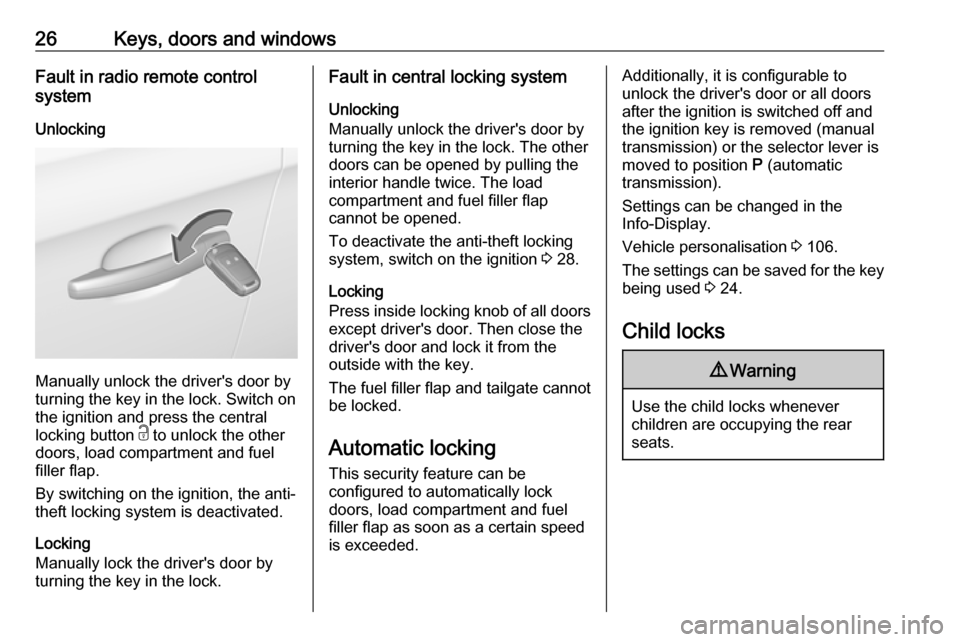
26Keys, doors and windowsFault in radio remote control
system
Unlocking
Manually unlock the driver's door by
turning the key in the lock. Switch on
the ignition and press the central
locking button c to unlock the other
doors, load compartment and fuel
filler flap.
By switching on the ignition, the anti-
theft locking system is deactivated.
Locking
Manually lock the driver's door by
turning the key in the lock.
Fault in central locking system
Unlocking
Manually unlock the driver's door by
turning the key in the lock. The other
doors can be opened by pulling the
interior handle twice. The load
compartment and fuel filler flap
cannot be opened.
To deactivate the anti-theft locking system, switch on the ignition 3 28.
Locking
Press inside locking knob of all doors
except driver's door. Then close the driver's door and lock it from the
outside with the key.
The fuel filler flap and tailgate cannot
be locked.
Automatic locking
This security feature can be
configured to automatically lock
doors, load compartment and fuel
filler flap as soon as a certain speed
is exceeded.Additionally, it is configurable to
unlock the driver's door or all doors after the ignition is switched off and
the ignition key is removed (manual
transmission) or the selector lever is
moved to position P (automatic
transmission).
Settings can be changed in the
Info-Display.
Vehicle personalisation 3 106.
The settings can be saved for the key being used 3 24.
Child locks9 Warning
Use the child locks whenever
children are occupying the rear
seats.
Page 38 of 267
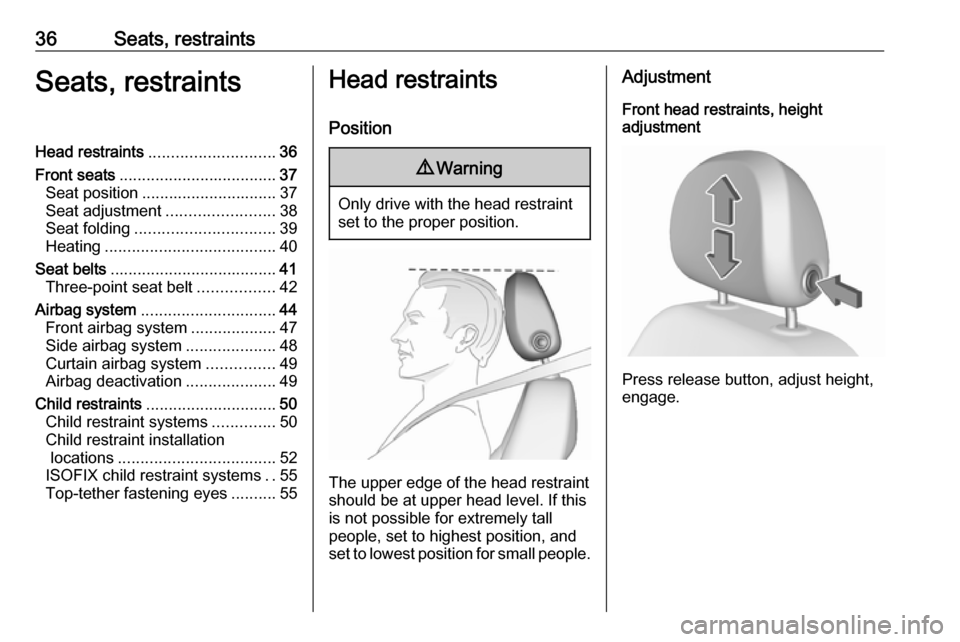
36Seats, restraintsSeats, restraintsHead restraints............................ 36
Front seats ................................... 37
Seat position .............................. 37
Seat adjustment ........................38
Seat folding ............................... 39
Heating ...................................... 40
Seat belts ..................................... 41
Three-point seat belt .................42
Airbag system .............................. 44
Front airbag system ...................47
Side airbag system ....................48
Curtain airbag system ...............49
Airbag deactivation ....................49
Child restraints ............................. 50
Child restraint systems ..............50
Child restraint installation locations ................................... 52
ISOFIX child restraint systems ..55
Top-tether fastening eyes ..........55Head restraints
Position9 Warning
Only drive with the head restraint
set to the proper position.
The upper edge of the head restraint
should be at upper head level. If this
is not possible for extremely tall
people, set to highest position, and
set to lowest position for small people.
Adjustment
Front head restraints, height
adjustment
Press release button, adjust height,
engage.
Page 39 of 267
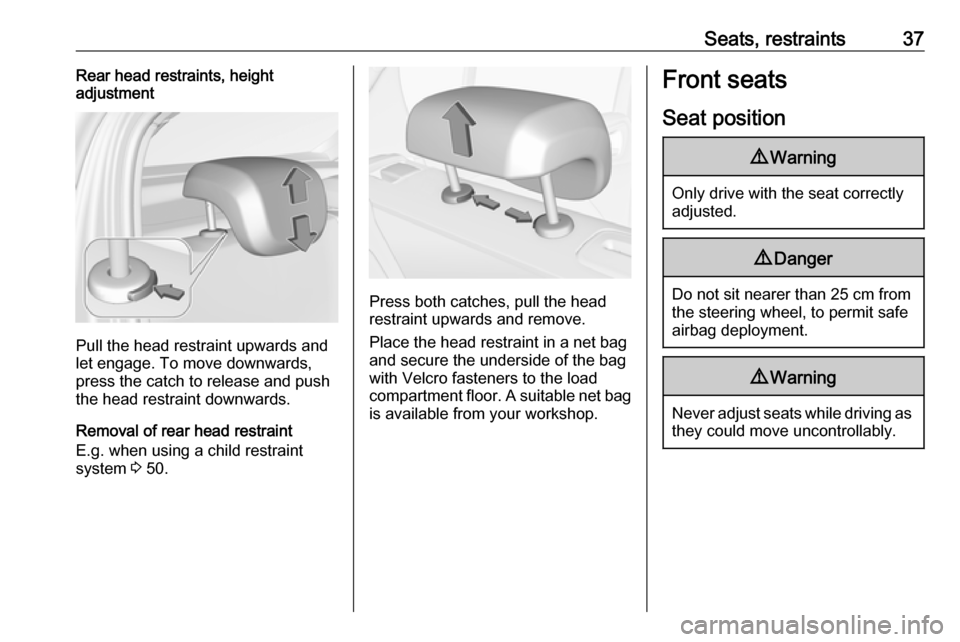
Seats, restraints37Rear head restraints, height
adjustment
Pull the head restraint upwards and
let engage. To move downwards, press the catch to release and push
the head restraint downwards.
Removal of rear head restraint
E.g. when using a child restraint
system 3 50.
Press both catches, pull the head
restraint upwards and remove.
Place the head restraint in a net bag
and secure the underside of the bag
with Velcro fasteners to the load
compartment floor. A suitable net bag
is available from your workshop.
Front seats
Seat position9 Warning
Only drive with the seat correctly
adjusted.
9 Danger
Do not sit nearer than 25 cm from
the steering wheel, to permit safe
airbag deployment.
9 Warning
Never adjust seats while driving as
they could move uncontrollably.
Page 40 of 267
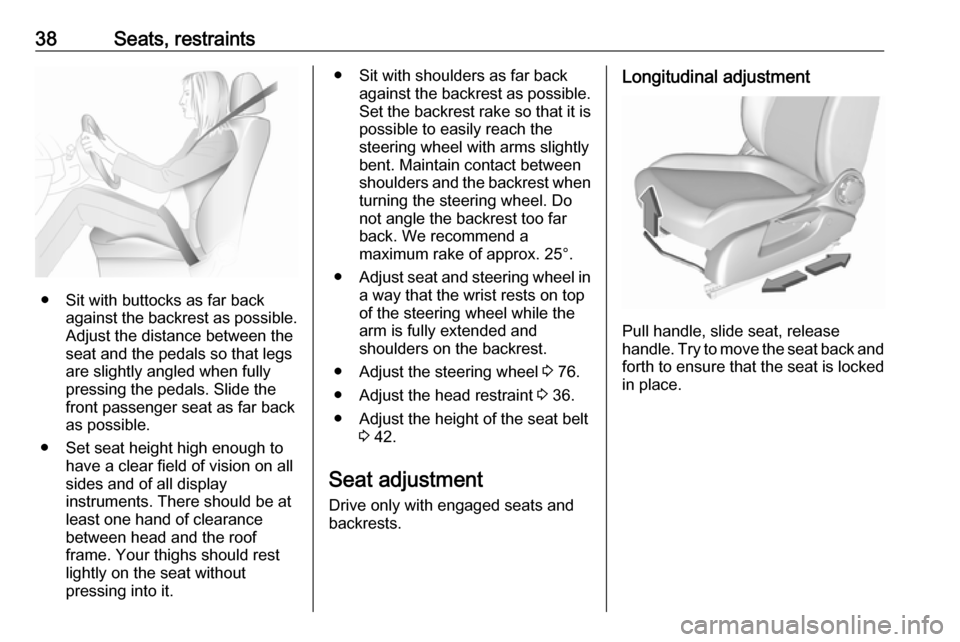
38Seats, restraints
● Sit with buttocks as far backagainst the backrest as possible.
Adjust the distance between the
seat and the pedals so that legs
are slightly angled when fully
pressing the pedals. Slide the
front passenger seat as far back
as possible.
● Set seat height high enough to have a clear field of vision on all
sides and of all display
instruments. There should be at
least one hand of clearance
between head and the roof
frame. Your thighs should rest
lightly on the seat without
pressing into it.
● Sit with shoulders as far back against the backrest as possible.
Set the backrest rake so that it is possible to easily reach the
steering wheel with arms slightly
bent. Maintain contact between
shoulders and the backrest when
turning the steering wheel. Do
not angle the backrest too far
back. We recommend a
maximum rake of approx. 25°.
● Adjust seat and steering wheel in
a way that the wrist rests on top
of the steering wheel while the
arm is fully extended and
shoulders on the backrest.
● Adjust the steering wheel 3 76.
● Adjust the head restraint 3 36.
● Adjust the height of the seat belt 3 42.
Seat adjustment
Drive only with engaged seats and
backrests.Longitudinal adjustment
Pull handle, slide seat, release
handle. Try to move the seat back and forth to ensure that the seat is locked
in place.
Page 41 of 267
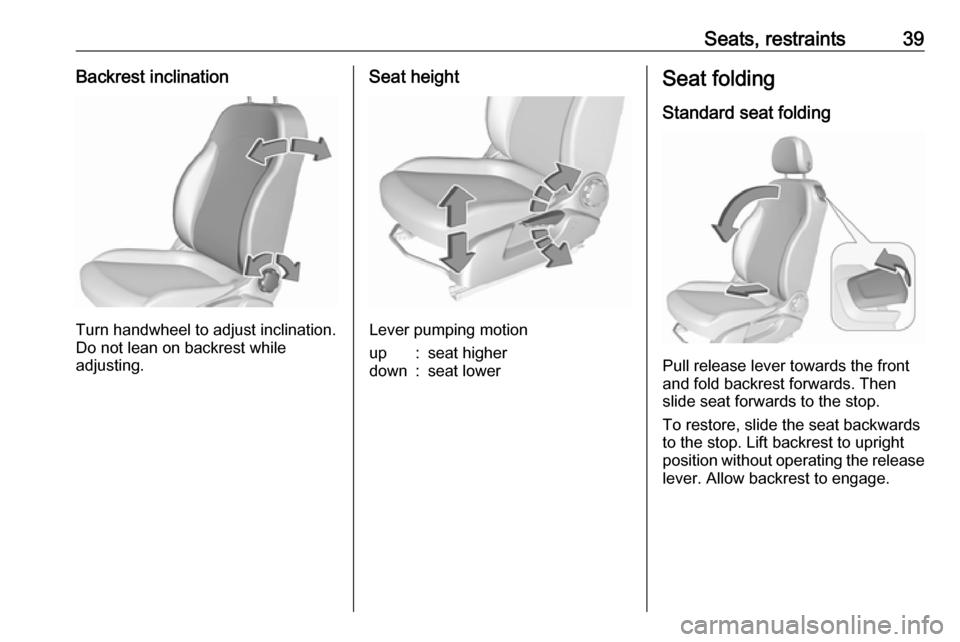
Seats, restraints39Backrest inclination
Turn handwheel to adjust inclination.
Do not lean on backrest while
adjusting.
Seat height
Lever pumping motion
up:seat higherdown:seat lowerSeat folding
Standard seat folding
Pull release lever towards the front
and fold backrest forwards. Then
slide seat forwards to the stop.
To restore, slide the seat backwards
to the stop. Lift backrest to upright
position without operating the release
lever. Allow backrest to engage.
Page 42 of 267
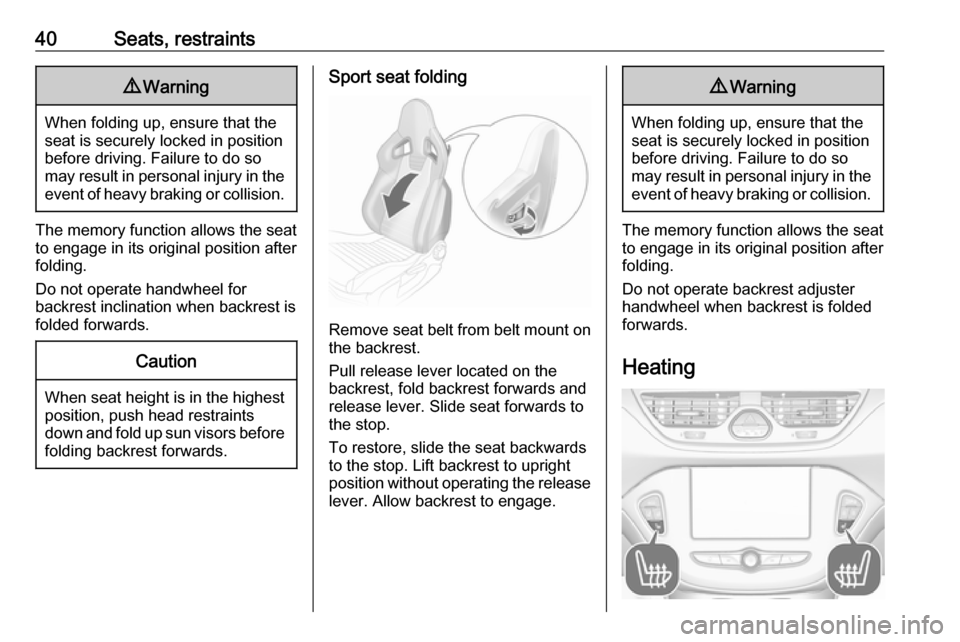
40Seats, restraints9Warning
When folding up, ensure that the
seat is securely locked in position
before driving. Failure to do so
may result in personal injury in the event of heavy braking or collision.
The memory function allows the seat
to engage in its original position after
folding.
Do not operate handwheel for
backrest inclination when backrest is
folded forwards.
Caution
When seat height is in the highest position, push head restraints
down and fold up sun visors before
folding backrest forwards.
Sport seat folding
Remove seat belt from belt mount on
the backrest.
Pull release lever located on the
backrest, fold backrest forwards and
release lever. Slide seat forwards to
the stop.
To restore, slide the seat backwards
to the stop. Lift backrest to upright
position without operating the release lever. Allow backrest to engage.
9 Warning
When folding up, ensure that the
seat is securely locked in position
before driving. Failure to do so
may result in personal injury in the event of heavy braking or collision.
The memory function allows the seat
to engage in its original position after
folding.
Do not operate backrest adjuster
handwheel when backrest is folded
forwards.
Heating
Page 43 of 267
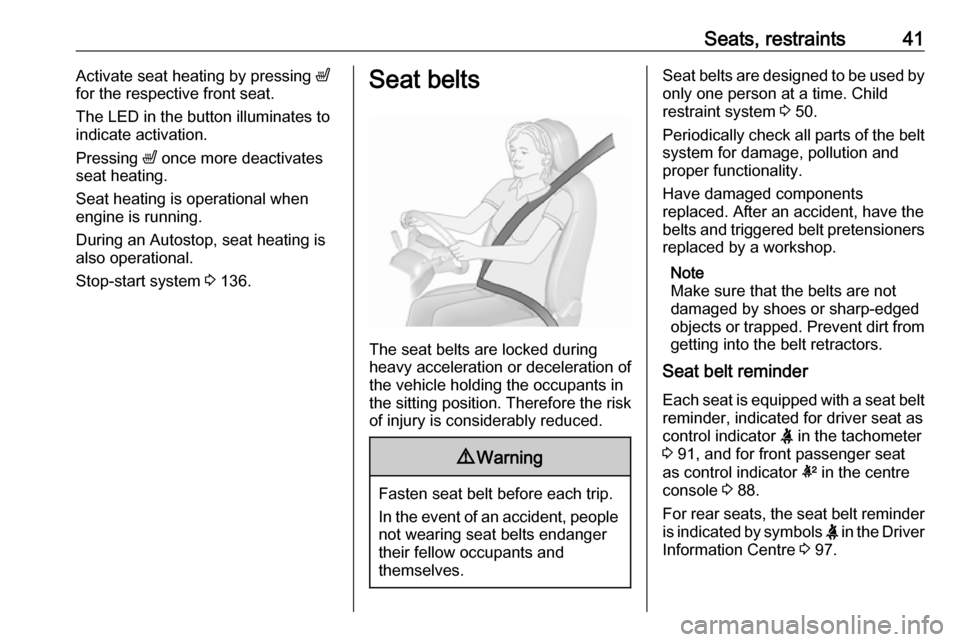
Seats, restraints41Activate seat heating by pressing ß
for the respective front seat.
The LED in the button illuminates to
indicate activation.
Pressing ß once more deactivates
seat heating.
Seat heating is operational when engine is running.
During an Autostop, seat heating is
also operational.
Stop-start system 3 136.Seat belts
The seat belts are locked during
heavy acceleration or deceleration of
the vehicle holding the occupants in
the sitting position. Therefore the risk
of injury is considerably reduced.
9 Warning
Fasten seat belt before each trip.
In the event of an accident, people
not wearing seat belts endanger their fellow occupants and
themselves.
Seat belts are designed to be used by only one person at a time. Child
restraint system 3 50.
Periodically check all parts of the belt
system for damage, pollution and
proper functionality.
Have damaged components
replaced. After an accident, have the
belts and triggered belt pretensioners replaced by a workshop.
Note
Make sure that the belts are not
damaged by shoes or sharp-edged
objects or trapped. Prevent dirt from
getting into the belt retractors.
Seat belt reminder
Each seat is equipped with a seat belt
reminder, indicated for driver seat as
control indicator X in the tachometer
3 91, and for front passenger seat
as control indicator k in the centre
console 3 88.
For rear seats, the seat belt reminder is indicated by symbols X in the Driver
Information Centre 3 97.
Page 44 of 267
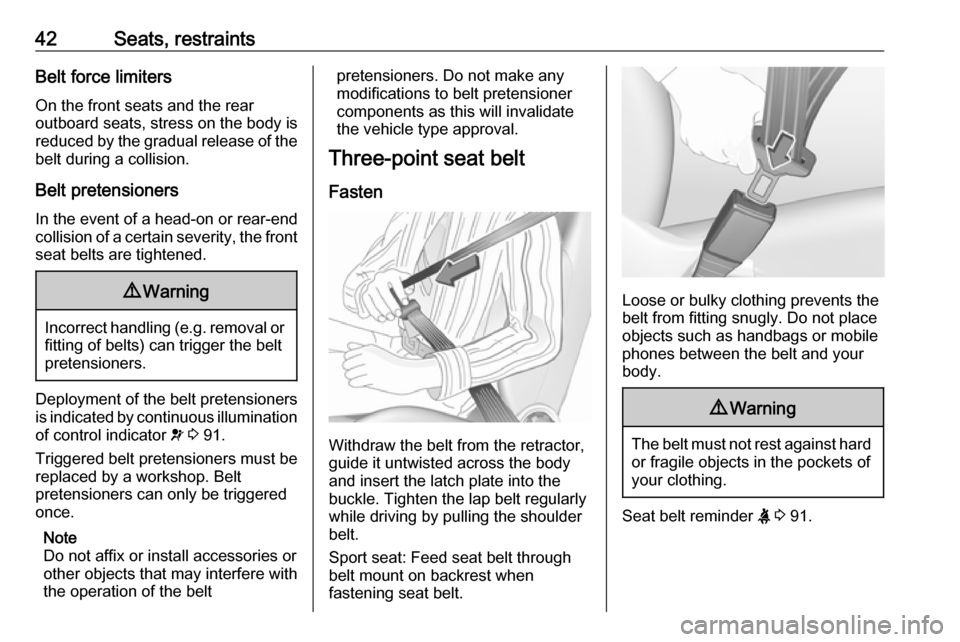
42Seats, restraintsBelt force limitersOn the front seats and the rear
outboard seats, stress on the body is
reduced by the gradual release of the belt during a collision.
Belt pretensioners In the event of a head-on or rear-end
collision of a certain severity, the front
seat belts are tightened.9 Warning
Incorrect handling (e.g. removal or
fitting of belts) can trigger the belt
pretensioners.
Deployment of the belt pretensioners
is indicated by continuous illumination
of control indicator v 3 91.
Triggered belt pretensioners must be replaced by a workshop. Belt
pretensioners can only be triggered
once.
Note
Do not affix or install accessories or
other objects that may interfere with
the operation of the belt
pretensioners. Do not make any
modifications to belt pretensioner components as this will invalidate
the vehicle type approval.
Three-point seat belt
Fasten
Withdraw the belt from the retractor,
guide it untwisted across the body
and insert the latch plate into the
buckle. Tighten the lap belt regularly
while driving by pulling the shoulder
belt.
Sport seat: Feed seat belt through
belt mount on backrest when
fastening seat belt.
Loose or bulky clothing prevents the
belt from fitting snugly. Do not place
objects such as handbags or mobile
phones between the belt and your body.
9 Warning
The belt must not rest against hard
or fragile objects in the pockets of
your clothing.
Seat belt reminder X 3 91.